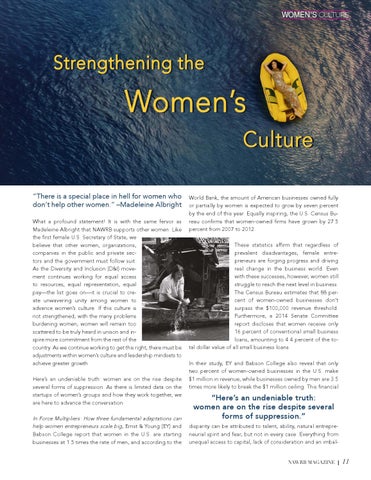WOMEN’S CULTURE
“There is a special place in hell for women who don’t help other women.” –Madeleine Albright What a profound statement! It is with the same fervor as Madeleine Albright that NAWRB supports other women. Like the first female U.S. Secretary of State, we believe that other women, organizations, companies in the public and private sectors and the government must follow suit. As the Diversity and Inclusion (D&I) movement continues working for equal access to resources, equal representation, equal pay—the list goes on—it is crucial to create unwavering unity among women to advance women’s culture. If this culture is not strengthened, with the many problems burdening women, women will remain too scattered to be truly heard in unison and inspire more commitment from the rest of the country. As we continue working to get this right, there must be adjustments within women’s culture and leadership mindsets to achieve greater growth. Here’s an undeniable truth: women are on the rise despite several forms of suppression. As there is limited data on the startups of women’s groups and how they work together, we are here to advance the conversation.
In Force Multipliers: How three fundamental adaptations can help women entrepreneurs scale big, Ernst & Young (EY) and Babson College report that women in the U.S. are starting businesses at 1.5 times the rate of men, and according to the
World Bank, the amount of American businesses owned fully or partially by women is expected to grow by seven percent by the end of this year. Equally inspiring, the U.S. Census Bureau confirms that women-owned firms have grown by 27.5 percent from 2007 to 2012. These statistics affirm that regardless of prevalent disadvantages, female entrepreneurs are forging progress and driving real change in the business world. Even with these successes, however, women still struggle to reach the next level in business. The Census Bureau estimates that 88 percent of women-owned businesses don’t surpass the $100,000 revenue threshold. Furthermore, a 2014 Senate Committee report discloses that women receive only 16 percent of conventional small business loans, amounting to 4.4 percent of the total dollar value of all small business loans. In their study, EY and Babson College also reveal that only two percent of women-owned businesses in the U.S. make $1 million in revenue, while businesses owned by men are 3.5 times more likely to break the $1 million ceiling. This financial
“Here’s an undeniable truth: women are on the rise despite several forms of suppression.” disparity can be attributed to talent, ability, natural entrepreneurial spirit and fear, but not in every case. Everything from unequal access to capital, lack of consideration and an imbal-
NAWRB MAGAZINE |
11
